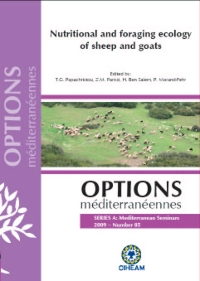| Article précédent | p. 117-121 | Article suivant |
Assessment of edible biomass production of Acacia senegal, Guiera senegalensis and Pterocarpus lucens in the Sahelian zone of West Africa
The aim of this work was to evaluate edible biomass production (total and accessible to animals while browsing) of three important browsing species in the Sahelian zone of Burkina Faso: Acacia senegal, Guiera senegalensis and Pterocarpus lucens. Biomass production was also estimated using dendrometric parameters. Accessible edible biomass varied according to the animal species (cattle, sheep or goats), the plant species and the height of plants. G. senegalensis produced the highest proportion of accessible biomass, but P. lucens had higher total edible biomass than the other two species. Goats browsing at higher height had more edible biomass at their disposal than cattle and sheep. Accessible edible biomass was weakly correlated with tree parameters (trunk diameter, crown diameter and height), while crown diameter was the best parameter to predict total edible biomass production, with R2 varying from 0.90 (G. senegalensis) to 0.98 (P. lucens), when dependent and independent variables were log-transformed. In conclusion, the single species models developed could be applied in similar agro-ecological zones by taking into account the height stratification of the plants.
La production de biomasse appétible (totale et accessible aux animaux) de trois espèces ligneuses importantes dans la zone sahélienne du Burkina Faso a été évaluée : Acacia senegal, Guiera senegalensis et Pterocarpus lucens. La production de biomasse appétible a été également estimée en utilisant les paramètres dendrométriques. La biomasse appétible et accessible a varié suivant l'espèce animale (bovin, ovin ou caprin), l'espèce végétale et la hauteur des plantes. G. senegalensis a produit la plus forte proportion de biomasse accessible, mais P. lucens avait la biomasse totale la plus élevée. Les caprins broutant à une hauteur plus élevée, avaient à leur disposition plus de biomasse appétible. Les corrélations entre la biomasse appétible et accessible et les paramètres des arbres (diamètre du tronc, diamètre du houppier et hauteur) étaient faibles, tandis que le diamètre du houppier était le meilleur paramètre pour prédire la production totale de biomasse appétible avec R2 variant de 0,90 (G. senegalensis) à 0,98 (P. lucens), suivant une transformation logarithmique des variables dépendantes et indépendantes. En conclusion, les modèles développés sont spécifiques par espèce et pourraient être appliqués dans des zones agro-écologiques similaires, en tenant compte de la stratification en hauteur des plantes.
- [ Afficher ]
- [ Télécharger ]
- [ Exporter la citation ]
Vous pouvez télécharger la citation au format :
- [ Imprimer ]
-
Mots-clés
ARBRE, BIOMASSE, BURKINA FASO, PATURAGE, PLANTE, RUMINANTCiter cet article
Sanon H.O., Ledin I. Assessment of edible biomass production of Acacia senegal, Guiera senegalensis and Pterocarpus lucens in the Sahelian zone of West Africa. In : Papachristou T.G. (ed.), Parissi Z.M. (ed.), Ben Salem H. (ed.), Morand-Fehr P. (ed.). Nutritional and foraging ecology of sheep and goats. Zaragoza : CIHEAM / FAO / NAGREF, 2009. p. 117-121. (Options Méditerranéennes : Série A. Séminaires Méditerranéens; n. 85). 12. Seminar on: Nutritional and Foraging Ecology of Sheep and Goats, 2007/10/11-13, Thessaloniki (Greece). http://om.ciheam.org/om/pdf/a85/00800994.pdf



